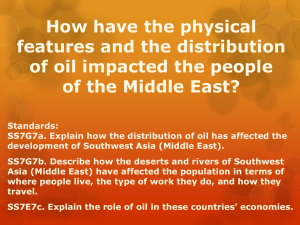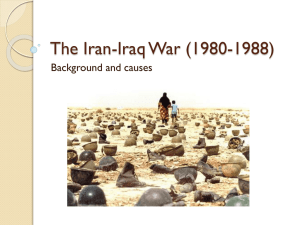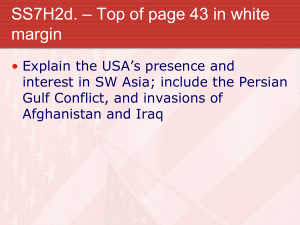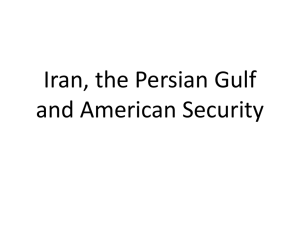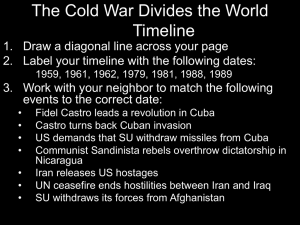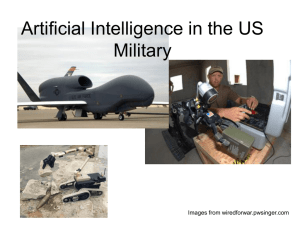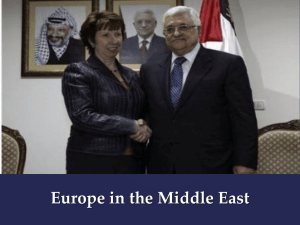The Iran-Iraq War (1980-1988)
advertisement
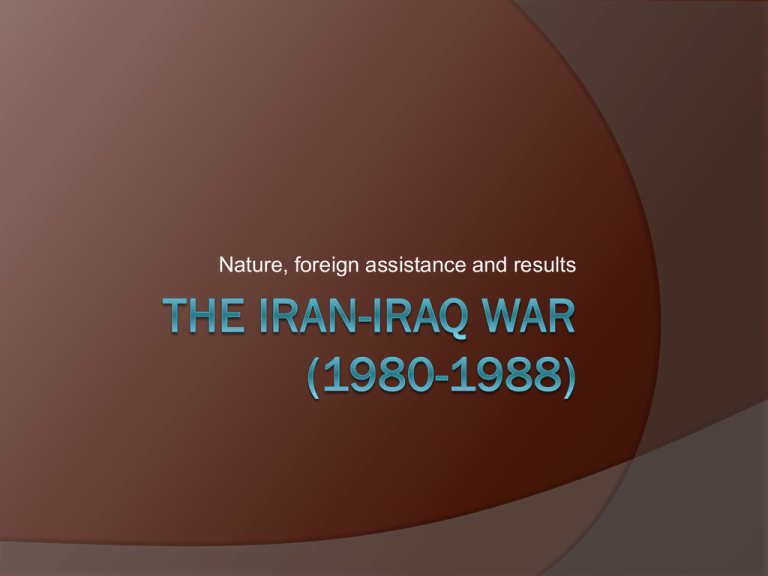
Nature, foreign assistance and results Course of the war Iraq invades Iran on 22 September 1980 1981: the Iraqi invasion stalls, Saddam begins to call for a settlement Mid 1982: Iran expels Iraq from Iranian territory July 1982: Operation Ramadan, launched on the holy month of Ramadan. Iran invades Iraq; the invader becomes the beleaguered. 1984: attacks on shipping and oil tankers begin (the “Tanker War”) 1985: the “War of the Cities” begin, with attacks and airstrikes on urban centres 1986: Iran captures the al-Faw peninsula in the south of Iraq August 1988: after major setbacks and fear of foreign intervention, Iran agrees to UN Resolution 598. Iraq launches a failed ten day offensive in an attempt to gain a more favourable settlement before agreeing to UN Resolution 598. Attrition warfare Attrition warfare is the reduction of the effectiveness of a force caused by loss of personnel and material. Attrition warfare attempts to destroy an enemy’s warwaging capabilities by: Attacking industrial resources and infrastructure Attacking civilian centres Eliminating military leadership Engaging with overwhelming force, fully employing all available military resources Shattering the enemy’s morale and reducing their capability to recover. Encouraging opposition groups to disrupt the war effort The Iran-Iraq War was characterised by trenches, dugouts, no-man’s land and minefields: comparable to World War One and synonymous with attrition warfare. Attrition warfare Attrition warfare was used to break the stalemate that developed. Why did a stalemate develop? Mistakes by the belligerents Inefficiencies on both sides Geography: Zagros Mountains, southern marshes, wide rivers Harsh conditions: hot summers; rains and flooding in the winter Iran hoped that attrition warfare would cause the Baathist regime to collapse from within: “Only an ideological motivated army like ours... are capable of mobilizing the people for a long war of attrition which we plan to wage until the Iraqi regime falls” –Revolutionary Guard Commander Morteza Rezai Iraq hoped that it would motivate Iran to negotiate a truce. Why Iraq failed to advance Saddam underestimated Iran. Iraq appeared to be stronger than Iran after the Iranian Revolution. The invasion invigorated patriotism and united the country, instead of exploiting its weakness as Saddam intended. The Iraqi Army had fought Kurdish guerrillas in the mountains for years prior to the Iran-Iraq War. The tactics used against the guerrillas were ineffective against regular armies and urban centres. Saddam insisted that he direct military operations, despite his lack of military training and experience. Iraq lacked clear goals and Saddam gave his troops too many objectives. Saddam executed generals who lost battles or retreated. Unlimited political objectives, limited military objectives Why Iran failed to advance Troops lacked military training Iranian tactics were ideologically sound but had little military success (eg: human wave tactics) Iran lacked spare parts for its arsenal of US weapons bought under the Shah Political influence in the army: A new class of religious commissars joined the ranks of the army to ensure there was no dissidence and that the soldiers upheld Revolutionary ideology Extensive purges in the army, eliminating educated officers from the Shah’s regime Heavy mismanagement; nearest Iranian division 50-60 miles from the border. Conduct of war: both belligerents Use of airstrikes and ballistic missiles to attack places of economic importance, particularly oil installations. “Tanker War”: disruption of trade by targeting oil tankers and merchant ships “War of the Cities”: direct attacks against urban populations The effect of this tactic is debatable. On one hand, it raised the morale of those affected by the attacks, affirming their commitment to the ruling regime. On the other hand, missile strikes were undetectable and unpredictable, instilling fear in many. Conduct of war: Iraq The use of chemical weapons was unique to Iraq and was apparent in the latter stages of the war: Used against Iranian soldiers in an attempt to retake al-Faw Used to commit genocide against the Iraqi Kurds for their insurgency against the government. One of the worst attacks occurred against the town of Halabja (March1988), which killed 20,000 and injured many others This greatly affected Iranian morale in the closing stages of the war Conduct of war: Iran The Iranian military contained a mix of the conventional army and various paramilitary groups. The Pasdaran was a key paramilitary group who represented and protected the ideals of the Iranian Revolution. The Basij militia (a branch of the Pasdaran) played a unique role in the Iran-Iraq War. The Basij carried out human wave attacks aimed at surprising the enemy. The Basij, were mobilised to clear minefields with their bodies and overwhelm entrenched Iraqi soldiers, so that regular forces could move freely The soldiers wore wooden or plastic keys around their neck, promised by the mullahs that this would bring them into the afterlife. Children as young as 12 were drafted into the Basij militia to engage in psychological warfare. Hojjat el-Eslam Salek (the head of the Basij) observed that the Basij were abandoning conventional warfare, and introducing a new “Islamic warfare”, thereby protecting Islamic Revolutionary ideals on the battlefield whilst utilising Iran’s superior population. Opposition groups Opposition groups shaped the nature of the war. Opposition groups in both Iran and Iraq used the war as an opportunity to mount a campaign against the ruling government. In Iraq, Iranian backed Shiite organisations mounted campaigns against the government, even assisting Iranian troops on the battlefield. The Kurds in the north waged a civil war against the Iraqi regime, forcing Iraq to fight a war on two fronts. In Iran, the Marxist People’s Mujahedin and the Kurdish minority (both supported by Iraq) took arms against the government. Through a system of terror and moral suasion, these opposition groups were rid by 1985. Ideological factors The Iran-Iraq War was a heavily ideological war. Khomeini repeatedly referred to the Iran-Iraq War as a jihad. He propagated the idea that it was a religious duty to fight evil and oppression against the Islamic faith, which was associated with Saddam Hussein’s secular and Shiite-oppressive regime. Death was portrayed as honourable in Iranian propaganda. Khomeini tapped into a deep religious principle called the “martyr complex”; the idea that death on the battlefield would bring one to heaven was based on Prophet Muhammad’s saying “Wish death and welcome afterlife”. Religious influence was seen in the Iranian military. Islamic mullahs were often present to lead and motivate troops in battle. Iran relied on faith and revolutionary zeal to motivate their troops on the battlefield, reminiscent of the zeal held by the Crusaders. This allowed the Iranians to achieve great feats on the battlefield. According to Khomeini “Victory is not achieved by swords, it can only be achieved by blood... it is achieved by strength of faith.” Ideological factors A common view held by historians is that the war ultimately galvanised a unique combination of religious zeal and deeprooted nationalism, encouraged after the Iranian Revolution. Behrouz Souresrafil differs from this view slightly. He disputes the Islamic nature of Iran’s war movement, stating that Islam was Khomeini’s cover to seize full power. Ideological factors For Iraq, Pan-Arabism emphasised unity between all Arabs against a bigoted and aggressive enemy. An important aspect of Iraqi propaganda was a cult of personality that embraced Saddam Hussein as the saviour of the nation. “Iraq’s population was at 26 million: 13 million Iraqis and 13 million pictures of Saddam.” After the invasion of Iraq by Iran, Iraqi propaganda shifted from “expansionism” to “defence of the nation” Recognising the importance of Islam, the secular Baathist regime began to adopt a pro-Islamic stance. Acts of generosity were extended to the Shiites Saddam embraced the “martyr complex” in his speeches Saddam attempted to portray himself as a pious muslim Attrition warfare Noncombatant involvement Role of opposition Conduct of war Ideological factors USA USA Alarmed by the aggressive and xenophobic nature of the new Iranian regime, the US wanted to prevent an Iranian takeover of the Middle East. Increased Iranian influence would threaten US interests in the region. Threatened by the attacks on shipping in the Tanker War, the US stepped in to protect freedom of navigation in the Arabian Gulf. Many Kuwaiti tankers (which transported Iraqi oil) were reflagged and were escorted under US protection. The US gave substantial financial assistance as well as providing arms for Iraq The US not only supported Iraq to counter Iran, but also to counter the USSR, who was also giving assistance to Iraq. However, the US was forced to support Iran covertly during the early stages of the war, in order to alleviate the hostage crisis which involved over 50 US diplomats. This was the source of public controversy which erupted in the Iran-Contra Affair. Other supporters of Iraq Gulf Cooperation Council (GCC): Arab countries like Saudi Arabia, Jordan and Kuwait supported Iraq because they were threatened by the spread of the Iranian Revolution, which undermined Sunni leadership and encouraged a Shiite uprising. The USSR: A long time supporter of the Baathist regime, despite Saddam’s attempts to distance himself from foreign support. The USSR wanted to play a role in the region to mitigate antagonism from Muslim nations, caused by the Soviet invasion of Afghanistan. The USSR also supported Iraq to prevent US penetration in the region. Other European nations: France, West Germany, UK and other western European nations supported Iraq to protect oil interests. Support from these countries came in the form of arms and financial assistance (military and non-military). Role of Israel Iran had isolated itself from Western and Middle Eastern nations after its aggressive actions. Iran had little to no allies and was in desperate need of supplies. Israel was surrounded by hostile states and needed a regional ally to counter the Arab League. At first, Israel became the indirect supplier of arms from the US (which caused controversy in the Iran-Contra Affair). Later, Israel directly provided arms and technicians Israel bombed Iraq’s Osirak nuclear reactor in 1981, to neutralise the threat to both Israel and Iran. It was believed that Iraq was developing nuclear weapons for the Iran-Iraq War. The Iranian invasion of Iraq corresponded closely with the Israeli invasion of Lebanon in 1982. This could be seen as an attempt to divide attention. Israeli support for Iran was mutually beneficial. The alliance was unlikely, given Iran’s anti-Zionist rhetoric. Other supporters of Iran However support was very limited for Iran. A few neutral countries, such as Spain and Yugoslavia, chose to supply both Iraq and Iran with arms. The only other major arms dealer for Iran was North Korea, which acted as a third party for arms deals from the communist bloc (both the USSR and China) Social Over a million people died on the battlefield, including both belligerents. Many more were injured or traumatised. The million people who died does not include those who died due to political persecution during the war. Despite a lack of military gain, nationalism pervaded as each side claimed victory over the other. Large monuments were erected in Iran and Iraq to celebrate the war. The war caused a scientific revolution in Iran. A new treatment was developed by Iranian physicians for the treatment of brain injuries, which was later adopted around the world. Iran’s promotion of the “martyr complex” influenced Islamic terrorists to undertake suicide bomb attacks as a new form of terrorism. Political Saddam Hussein was recognised as the strong leader of Iraq. A short period of political unity occurred after the war. Political groups were willing to unite under the leadership of Saddam. The build up of arms in Iraq during the war would have disastrous consequences. Iraq’s debt and increased military strength motivated Iraq to invade Kuwait in 1990. The years following the Gulf War included efforts by the UN to disarm Iraq. Dissatisfaction with this contributed to the Iraq War in 2003. Khomeini died shortly after the war. Progressive leaders won power from the conservatives, encouraging an era of reform. Borders returned to the ones set up by the 1975 Algiers Agreement Economic The war cost in total (for both belligerents) over 1 trillion USD (not including inflation) including GNP losses, debt, oil revenue losses and damage Oil production in both countries became severely affected Iraq was severely affected. Iraq accumulated 70 billion USD (not including inflation). After the Gulf War in 1990, Iraq’s Debt-to-GDP ratio was over 1000%. With bloodier and cheaper tactics, Iran escaped the war with little debt, which allowed the country to focus on rebuilding and reform Total war? Yes Heavy use of propaganda and recruitment on both sides Civilians were heavily affected by the War of the Cities Both economies focused on the war effort The war saw heavy casualties and brutal atrocities Heavily centralised government control of the war effort The war attracted the attention of foreign powers Neither belligerent had tangible gains after the war For Iran it was a total war. War became a central part of the Iranian mentality. The entire population was mobilised for the war effort. Many men were drafted from all ages. Non-combatants held pro-war rallies, which widely reported. The Iran-Iraq War became an extension of the Iranian Revolution. Total war? No Conflict limited and static to the border of Iran and Iraq Limited military objectives despite unlimited political objectives No direct foreign intervention For Iraq it wasn’t a total war. Iraq never committed its entire military to the frontline. Iraq also adopted a “business as usual” policy, allowing construction projects to continue. There was a great attempt to shield Iraqi citizens from the war. Video time! ☺ http://video.google.com/videoplay?docid =-8979584909588245820#
